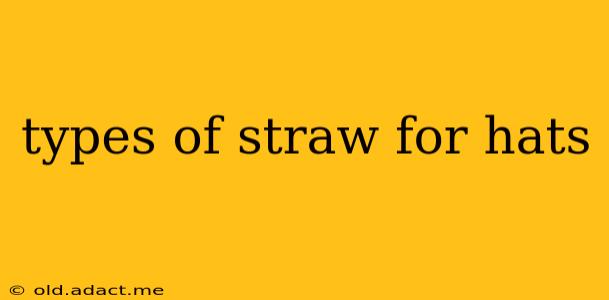Straw hats are a timeless accessory, offering sun protection and style in equal measure. But the seemingly simple straw hat hides a world of variety in the materials used to create them. Understanding the different types of straw used can help you appreciate the craftsmanship and choose a hat that best suits your needs and style. This guide dives into the diverse world of hat-making straws, exploring their characteristics and uses.
What are the different types of straw used for hats?
This is a broad question, as many different grasses and plants can be processed into straw suitable for hat making. The type of straw significantly impacts the hat's weight, durability, texture, and overall appearance. Here are some of the most common:
1. Toquilla Straw (Panama Hats):
This straw, sourced from the Carludovica palmata plant (not actually a grass), is renowned for its exceptional fineness and creates the iconic Panama hat. The finer the weave, the higher the quality and price. Genuine Panama hats are known for their lightweight nature, breathability, and durability.
What makes Toquilla straw unique? Its exceptionally fine fibers allow for intricate weaving, resulting in incredibly lightweight and durable hats. The higher the "pleat" (number of weaves per inch), the finer and more expensive the hat.
2. Raffia Straw:
Raffia comes from the raffia palm tree and is a natural fiber known for its versatility and durability. It's coarser than toquilla, resulting in a more textured and rustic look. Raffia hats are often more affordable than Panama hats but still offer excellent sun protection.
What are the characteristics of Raffia straw? Its natural color ranges from light beige to dark brown. It's relatively easy to work with, which often leads to a more playful design aesthetic.
3. Seagrass Straw:
As the name suggests, seagrass straw is harvested from seagrass plants. It’s naturally water-resistant and durable, making it ideal for hats worn in humid or coastal environments. Seagrass hats often have a unique, slightly coarse texture and a natural golden color.
Why choose Seagrass straw? Its natural water-resistance makes it perfect for beach days or rainy climates. It's also often quite sustainable, as seagrass is a rapidly renewable resource.
4. Paper Straw:
Don't let the name mislead you! Paper straw isn't made from the paper you write on. It is a processed material made from a pulp formed from various plants (often wheat straw). It can be woven into various textures, providing a range of finishes from fine to coarse. Paper straw is a popular choice for its affordability and versatility.
What are the benefits of Paper Straw? It's often more affordable than other types of straw and offers a wide range of design possibilities.
5. Hemp Straw:
Derived from the hemp plant, this straw offers a sustainable and durable option for hat making. Hemp straw hats are known for their strength and environmental friendliness. They often have a slightly rougher texture compared to toquilla or raffia.
Is Hemp straw eco-friendly? Absolutely! Hemp is a rapidly renewable resource that requires little to no pesticides or herbicides, making it a very sustainable choice.
6. Wheat Straw:
As the name suggests, wheat straw is made from wheat stalks. It's a commonly used and sustainable material, particularly popular in the production of more affordable hats. The color is typically a light beige or golden hue.
What is the texture of Wheat Straw? It's typically quite lightweight and flexible, making it suitable for a wide variety of hat designs.
What are some other types of materials used in hat-making?
While straw is a dominant material, hat makers also utilize other materials:
- Wool Felt: Used for making stylish fedoras and other structured hats, offering warmth and durability.
- Leather: Used for details, bands, and sometimes for entire hat structures, providing durability and a luxurious feel.
- Synthetic Materials: Offer affordable and often water-resistant options for hats, frequently used for casual styles.
Understanding the types of straw used in hat making allows you to appreciate the artistry and craftsmanship involved in creating these stylish and functional accessories. Remember to consider factors such as durability, comfort, and aesthetic when choosing a straw hat that complements your style and needs.
